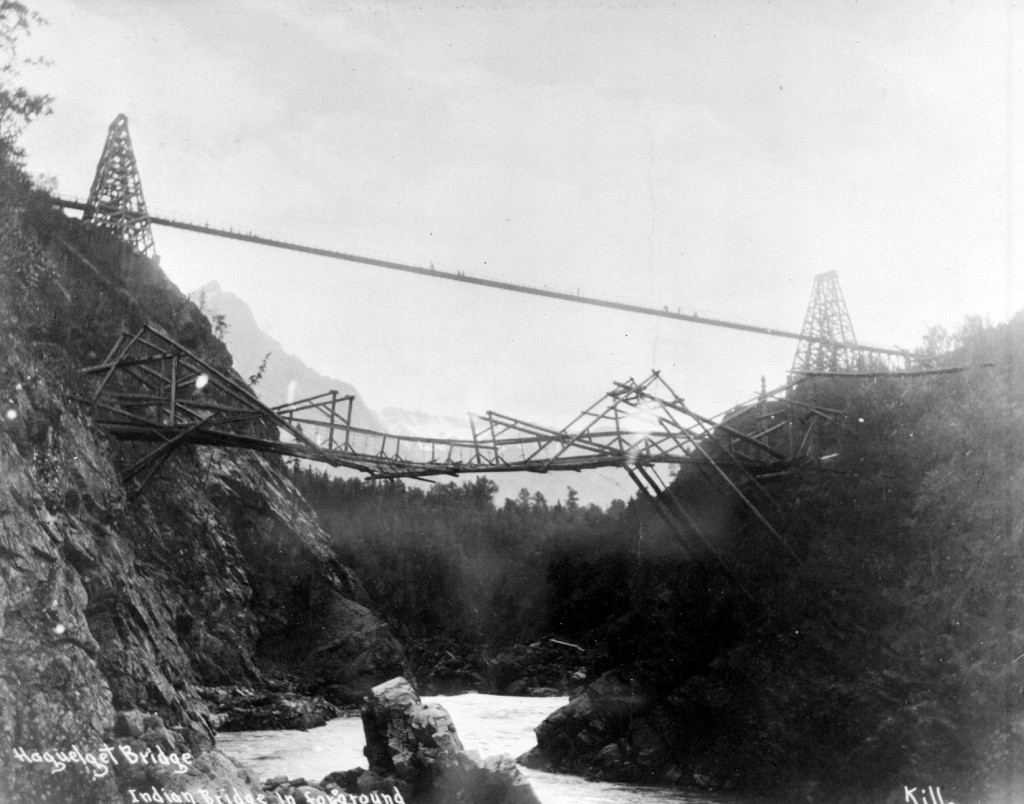
From planks and cedar ropes, to steel and concrete, the Hagwilget Bridge near Hazelton has evolved over a span of well over 150 years.
Every year, about 50,000 tourists are drawn by the area’s wilderness scenery, outdoors opportunities and cultural interests to cross the 140-metre long steel and cable bridge and visit historic Old Town Hazelton, Kispiox Village and the K’San Historical Village and Museum. Interpretive signs are posted by the bridge, and nearby Eagle Down Trail offers a dazzling look at the Seven Sister Mountains. About 29 metres north, the concrete footings of a 1914 bridge remain.
The first Hagwilget Bridge in written and photographic record, was ingeniously constructed by local Indigenous people. (Earlier bridges are known through Indigenous oral histories.) Charles Morison, who visited the area in 1866 to install the Collins Western Union Overland Telegraph wrote, “They had built a wonderful bridge across the Bulkley River Canyon on the cantilever principle, a bridge with not a single nail or piece of iron in its composition nothing but wooden pegs and all the timber fastened together with cedar withes, it was really a wonderful piece of work.”

The second suspension bridge was also built of wood, with additional supports added. It spanned about 150 feet across the craggy Bulkley River canyon, some 200 feet above the rushing waters. Telegraph wire abandoned by Morison’s employer, was later used to strengthen the bridge.
These bridges were part of a vital trade route which connected the Gitxsan and Wet’suwet’en communities, and other inland First Nations communities, with coastal First Nations. Hunters, traders, explorers and prospectors travelled its six-foot width.
As the years passed, the bridge’s composition and uses continued to change.

Settler communities formed around the Skeena and Bulkley Rivers, and eventually a new nine-foot wide bridge of wood and wrought iron was built downstream from the Indigenous-built bridge. The provincial government’s Land and Works Department (now the Ministry of Transportation and Infrastructure) hired the wire and cable company of Craddock and Co., to complete the new bridge in 1914.
As time and technology progressed, this bridge was replaced by one to accommodate heavier loads. Alexander Carruthers designed the new bridge for the B.C. Department of Public Works, in Victoria. The bridge, opened in 1932, was then the highest suspension bridge in Canada.
This Hagwilget Bridge has had some major work since. In 1990, the BC Ministry of Transportation hired engineers Buckland & Taylor Ltd. to increase the bridge’s capacity to handle loads. Further upgrades were made in 2003 and 2012, and the ministry continues to regularly maintains and inspect the structure. This ensures that commercial vehicles, residents and tourists will continue to safely cross over the plunging Bulkley River Canyon, while admiring the impressive view.
To cross the Hagwilget Bridge over the Bulkley River is to journey a historic route used for hundreds, if not thousands of years. For the full dizzying experience, walk across the bridge and look 80 metres down into the craggy depths of the canyon, while imagining it’s one of the earlier cedar rope and wood Hagwilget bridges. The trip is a tribute to bridge builders of long ago and today.
Our appreciation goes to the Royal BC Museum and Regional District of Kitimat-Stikine Heritage Registry for their research from which we have drawn many facts.
For more transportation history, see Frontier to Freeway; A short illustrated history of the roads in British Columbia, published by the Ministry of Transportation and Highways.
Learn more about Indigenous imprints on BC transportation infrastructure:
I think I read somewhere that the 1914 bridge was relocated up the Bulkley River to Walcott Station where it now serves as a pedestrian bridge.
Very interesting Jean. Our native Australian aborigines also are great innovators, using creative ways to fix problems out in the ‘bush,’ as we say of the wide open spaces with no services or repair shops if their vehicles break down.